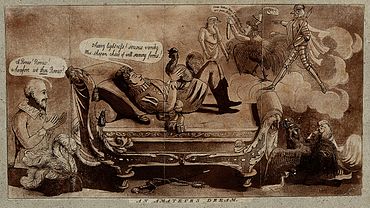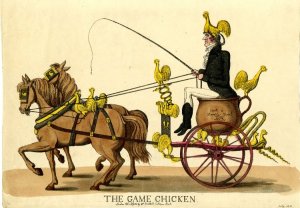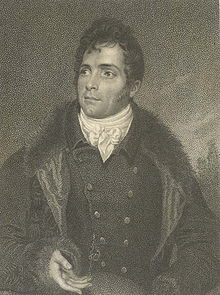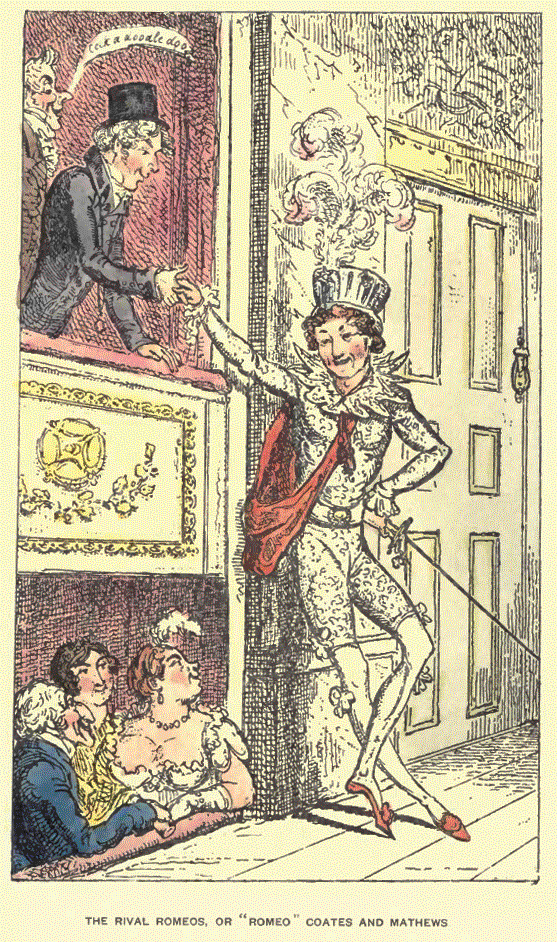 Robert “Romeo” Coates (1772-1848) was an eccentric who believed he was the best actor in the world, dressed in a pile of furs even in the summer, rode around in a curricle shaped like a cockleshell, and brought audiences to the theater…but mostly to take the mickey.
Robert “Romeo” Coates (1772-1848) was an eccentric who believed he was the best actor in the world, dressed in a pile of furs even in the summer, rode around in a curricle shaped like a cockleshell, and brought audiences to the theater…but mostly to take the mickey.
Yep, this is the story of a man foisted on the petard of his overweening self confidence.
 Sent to England for education, Coates wanted to enter the military. But his parents refused, and so he returned for a time to the West Indies for idleness (https://thebathmagazine.co.uk/alas-poor-romeo-baths-worst-actor/). His interest in amateur theatrics doubtless rose from so much free time. There was also limited entertainment for residents of Antigua, most people relying on the start up amateur theater, so that Coates performances there were applauded (Robinson, 1891). So enthralled with drama, Coates soon left off all desire to gain another profession and threw himself into the world of the theater (Robinson, 1891).
Sent to England for education, Coates wanted to enter the military. But his parents refused, and so he returned for a time to the West Indies for idleness (https://thebathmagazine.co.uk/alas-poor-romeo-baths-worst-actor/). His interest in amateur theatrics doubtless rose from so much free time. There was also limited entertainment for residents of Antigua, most people relying on the start up amateur theater, so that Coates performances there were applauded (Robinson, 1891). So enthralled with drama, Coates soon left off all desire to gain another profession and threw himself into the world of the theater (Robinson, 1891).
 When his father passed in 1807, Coates hightailed it back to England and ended up in Bath (https://thebathmagazine.co.uk/alas-poor-romeo-baths-worst-actor/). His appearance, including hundreds of diamonds embellished on shirt buttons, shoe buckles, cane and garter earned him the nickname “Diamond”. Piling on the furs, wearing bright colors coats, breeches and multi-coloured cravats, sticking feathers in his hats, his extreme, comical expression of Dandyism was underlined by his design for a carriage. The two wheeled curricle was shaped like a shell, pulled by two white horses, and featured his mascot (a crowing fighting cockerel) ( https://thebathmagazine.co.uk/alas-poor-romeo-baths-worst-actor/). He also received the sometimes moniker of “Curricle Coates” for his carriage, or “Amateur of Fashion” for his over the top fashion sense. His love of fashion extended to the design of his own costumes, which he carried with him on his travels (and sometimes wore around as streetwear).
When his father passed in 1807, Coates hightailed it back to England and ended up in Bath (https://thebathmagazine.co.uk/alas-poor-romeo-baths-worst-actor/). His appearance, including hundreds of diamonds embellished on shirt buttons, shoe buckles, cane and garter earned him the nickname “Diamond”. Piling on the furs, wearing bright colors coats, breeches and multi-coloured cravats, sticking feathers in his hats, his extreme, comical expression of Dandyism was underlined by his design for a carriage. The two wheeled curricle was shaped like a shell, pulled by two white horses, and featured his mascot (a crowing fighting cockerel) ( https://thebathmagazine.co.uk/alas-poor-romeo-baths-worst-actor/). He also received the sometimes moniker of “Curricle Coates” for his carriage, or “Amateur of Fashion” for his over the top fashion sense. His love of fashion extended to the design of his own costumes, which he carried with him on his travels (and sometimes wore around as streetwear).

His performances on the stage in England were treated with the same mixture of fascination, scorn and horror as his outlandish appearance. At his first appearance as Romeo in Bath, the gallery became restless:
One attendee described Coates as “one of the most grotesque spectacles ever witnessed upon the stage,” with “a spangled coat of sky blue silk, crimson pantaloons,” lots of diamonds and a baroque wig (https://thebathmagazine.co.uk/alas-poor-romeo-baths-worst-actor). Coates also paused at the famous balcony scene to take a pinch of snuff and then offer it to aghast/amused audience members, forgot or “improved” upon his lines, and bust the seams of his crimson breeches. Apparently, his clothes were so tight he walked about the stage with a strange, stiff waddle (https://thebathmagazine.co.uk/alas-poor-romeo-baths-worst-actor/). Members of the audience yelled to “Die Again, Romeo,” so he obliged twice more. Juliet emerged from the wings to stop his third attempt, and the producer dropped the curtain to bring the farce to an end (https://thebathmagazine.co.uk/alas-poor-romeo-baths-worst-actor/).
His appearance as Romeo in Richland fared a little better:
Any of the criticisms, yelling, or flying objects were treated by Coates as praise. Totally oblivious, he would continue his tour around England.
Coates’ first appearance in London, in 1811 at Haymarket, was a total disaster. The noise upon the
Robinson, 1891, p. 46-47).
Coates settled down a bit after marriage in 1823 and died at age 76 in 1848 when he was hit by a hansom cab after leaving the Theater.
From the 1875 English Eccentrics and Eccentricities:
Robinson, J and H. Robinson (1891). The Life of Robert Coates: Better Known as “Romeo” and “Diamond”. (https://books.google.com/books?id=yRgPAAAAIAAJ&pg=PA244&dq=romeo+coates&hl=en&sa=X&ved=0ahUKEwi0mpWMxYvfAhXiITQIHV1yCoAQ6AEIKDAA)









